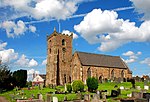Brookvale Groby Learning Campus
Brookvale Groby Learning Campus is a coeducational secondary school and sixth form located in Groby in the English county of Leicestershire.The school was created in September 2012 from Groby Community College and Brookvale High School. Previously they were both community schools administered by Leicestershire County Council. Both schools converted to academy status in partnership in July 2012. As the former schools were sited next to each other, the combined school teaches across an amalgamated campus. Brookvale Groby Learning Campus offers GCSEs and BTECs as programmes of study for pupils, while students in the sixth form have the option to study from a range of A Levels and further BTECs.
Excerpt from the Wikipedia article Brookvale Groby Learning Campus (License: CC BY-SA 3.0, Authors).Brookvale Groby Learning Campus
Ratby Road, Hinckley and Bosworth Groby
Geographical coordinates (GPS) Address Nearby Places Show on map
Geographical coordinates (GPS)
| Latitude | Longitude |
|---|---|
| N 52.6584 ° | E -1.2356 ° |
Address
Ratby Road
LE6 0BS Hinckley and Bosworth, Groby
England, United Kingdom
Open on Google Maps









